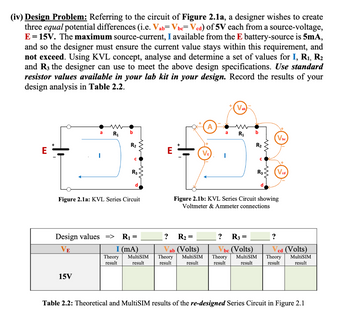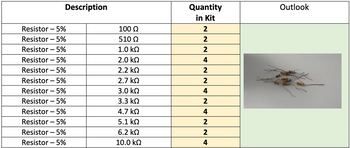
Introductory Circuit Analysis (13th Edition)
13th Edition
ISBN: 9780133923605
Author: Robert L. Boylestad
Publisher: PEARSON
expand_more
expand_more
format_list_bulleted
Concept explainers
Question
thumb_up100%
A list of resistor values that can be used for this problem have been provided as an image. Complete the design problem using the information given as well as Figure 2.1a. Include all calculations and steps. Ignore the MultiSIM aspect of the question, and ignore the MultiSIM input sections when filling out Table 2.2. Thank you very much!

Transcribed Image Text:(iv) Design Problem: Referring to the circuit of Figure 2.1a, a designer wishes to create
three equal potential differences (i.e. Vab= Vbc=Vcd) of 5V each from a source-voltage,
E = 15V. The maximum source-current, I available from the E battery-source is 5mA,
and so the designer must ensure the current value stays within this requirement, and
not exceed. Using KVL concept, analyse and determine a set of values for I, R₁, R₂
and R3 the designer can use to meet the above design specifications. Use standard
resistor values available in your lab kit in your design. Record the results of your
design analysis in Table 2.2.
E
ww
a R₁
15V
b
R₂
Theory
result
с
Figure 2.1a: KVL Series Circuit
R3
Design values => R₁ =
VE
I (mA)
MultiSIM
result
?
R₂ =
ab (Volts)
Theory
result
VE
a
MultiSIM
result
I
Vab
R₁
? R3
b
=
R₂
Figure 2.1b: KVL Series Circuit showing
Voltmeter & Ammeter connections
C
be (Volts)
Theory MultiSIM
result
result
R3
Vbc
?
Ved (Volts)
Theory MultiSIM
result
result
Table 2.2: Theoretical and MultiSIM results of the re-designed Series Circuit in Figure 2.1

Transcribed Image Text:Description
Resistor - 5%
Resistor - 5%
Resistor 5%
Resistor 5%
Resistor - 5%
Resistor - 5%
Resistor - 5%
Resistor - 5%
Resistor - 5%
Resistor - 5%
Resistor - 5%
Resistor - 5%
100 Ω
510 Ω
1.0 kQ
2.0 ΚΩ
2.2 ΚΩ
2.7 ΚΩ
3.0 ΚΩ
3.3 ΚΩ
4.7 ΚΩ
5.1 ΚΩ
6.2 ΚΩ
10.0 ΚΩ
Quantity
in Kit
2
2
2
4
2
2
4
2
4
224
Outlook
Expert Solution
This question has been solved!
Explore an expertly crafted, step-by-step solution for a thorough understanding of key concepts.
Step by stepSolved in 3 steps with 3 images

Knowledge Booster
Learn more about
Need a deep-dive on the concept behind this application? Look no further. Learn more about this topic, electrical-engineering and related others by exploring similar questions and additional content below.Similar questions
- Plot the input/output characteristics of the circuits shown below using both ideal diode mode and constant-voltage model with VD, on= 0.8 V, where R₁= 2k, and R₂= 5 KQ, and VB 1.8 V in (c). (a) (c) D₁ R₁ Vinº * W R1 + WWF K D2R₂ D₁ ww Vout o Vout R₂ (b) Vino D₁ . R₁ KWI D₂ R₂ Voutarrow_forwardYou are an electrician working on an overhead crane. The crane uses a large electromagnet to pick up large metal pipes. The magnet must have a minimum of 200 VDC to operate properly. The crane has an AC source of 240 V. You are given four diodes that have a peak voltage rating of 400 V each. These diodes are to be used to form a bridge rectifier to convert the AC voltage into DC voltage. Is the voltage rating of the diodes sufficient? To the nearest volt, what will be the DC output voltage of the bridge rectifier?arrow_forwardElectrical Engineering - elctronic Please solve the question quicklyarrow_forward
- You are an electrician working on an overhead crane. The crane uses a large electromagnet to pick up large metal pipes. The magnet must have a minimum of 200 VDC to operate properly. The crane has an AC source of 240 V. You are given four diodes that have a peak voltage rating of 400 V each. These diodes are to be used to form a bridge rectifier to convert the AC voltage into DC voltage. Is the voltage rating of the diodes sufficient? To the nearest volt, what will be the DC output voltage of the bridge rectifier?arrow_forwardCalculate the equivalent resistances Rin of the following circuits. (The resistance value of the diodes in the conduction will be 0, the resistance value of the diodes in the insulation will be taken as infinity. R1=10ohmarrow_forwardFind voltage regulation in typing format please ASAP for the likearrow_forward
arrow_back_ios
arrow_forward_ios
Recommended textbooks for you
 Introductory Circuit Analysis (13th Edition)Electrical EngineeringISBN:9780133923605Author:Robert L. BoylestadPublisher:PEARSON
Introductory Circuit Analysis (13th Edition)Electrical EngineeringISBN:9780133923605Author:Robert L. BoylestadPublisher:PEARSON Delmar's Standard Textbook Of ElectricityElectrical EngineeringISBN:9781337900348Author:Stephen L. HermanPublisher:Cengage Learning
Delmar's Standard Textbook Of ElectricityElectrical EngineeringISBN:9781337900348Author:Stephen L. HermanPublisher:Cengage Learning Programmable Logic ControllersElectrical EngineeringISBN:9780073373843Author:Frank D. PetruzellaPublisher:McGraw-Hill Education
Programmable Logic ControllersElectrical EngineeringISBN:9780073373843Author:Frank D. PetruzellaPublisher:McGraw-Hill Education Fundamentals of Electric CircuitsElectrical EngineeringISBN:9780078028229Author:Charles K Alexander, Matthew SadikuPublisher:McGraw-Hill Education
Fundamentals of Electric CircuitsElectrical EngineeringISBN:9780078028229Author:Charles K Alexander, Matthew SadikuPublisher:McGraw-Hill Education Electric Circuits. (11th Edition)Electrical EngineeringISBN:9780134746968Author:James W. Nilsson, Susan RiedelPublisher:PEARSON
Electric Circuits. (11th Edition)Electrical EngineeringISBN:9780134746968Author:James W. Nilsson, Susan RiedelPublisher:PEARSON Engineering ElectromagneticsElectrical EngineeringISBN:9780078028151Author:Hayt, William H. (william Hart), Jr, BUCK, John A.Publisher:Mcgraw-hill Education,
Engineering ElectromagneticsElectrical EngineeringISBN:9780078028151Author:Hayt, William H. (william Hart), Jr, BUCK, John A.Publisher:Mcgraw-hill Education,

Introductory Circuit Analysis (13th Edition)
Electrical Engineering
ISBN:9780133923605
Author:Robert L. Boylestad
Publisher:PEARSON

Delmar's Standard Textbook Of Electricity
Electrical Engineering
ISBN:9781337900348
Author:Stephen L. Herman
Publisher:Cengage Learning

Programmable Logic Controllers
Electrical Engineering
ISBN:9780073373843
Author:Frank D. Petruzella
Publisher:McGraw-Hill Education

Fundamentals of Electric Circuits
Electrical Engineering
ISBN:9780078028229
Author:Charles K Alexander, Matthew Sadiku
Publisher:McGraw-Hill Education

Electric Circuits. (11th Edition)
Electrical Engineering
ISBN:9780134746968
Author:James W. Nilsson, Susan Riedel
Publisher:PEARSON

Engineering Electromagnetics
Electrical Engineering
ISBN:9780078028151
Author:Hayt, William H. (william Hart), Jr, BUCK, John A.
Publisher:Mcgraw-hill Education,